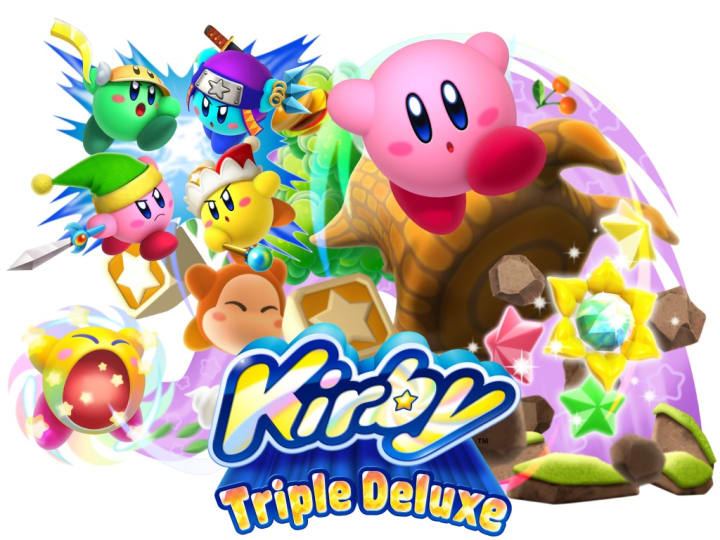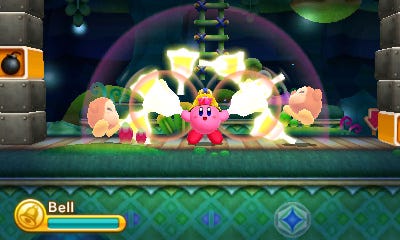Kirby Triple Deluxe (3DS, 2014)
A bright and colorful Kirby adventure that feels just a bit slow.
Nostalgia Factor: Medium.
Difficulty: Easy. A few challenges towards the end.


Have you ever had a gaming slump? This didn’t use to happen to me when I was younger. I think this is a mid-life phenomenon, now that I’m in my 30s. I’ve had a few of these gaming slumps in recent years. I actually wrote at length about the nature of this (ADHD vs. OCD gaming) if you want to read more. Sadly, I must report that Kirby Triple Deluxe was largely responsible for my latest gaming slump.
I was firmly committed to playing through Triple Deluxe, and I didn’t want to let other games distract me from that goal, but whenever I had an hour or two for gaming, I just couldn’t bring myself to play Triple Deluxe. I encountered a significant lull in the middle of the game. It just wasn’t giving me those “gotta play it” vibes like other games have.
Let’s start with the good before I explain why Triple Deluxe caused a slump.
The Good.
Considering the limitations of the 3DS, this game looks very good. Since the 3DS doesn’t boast much in pixel clarity (with a shockingly low 400x240 effective resolution), the best 3DS developers wisely focused on color instead. And boy, did the HAL team crank up the vibrant colors for this release. The Hypernova mode showcases this in particular.
Speaking of Hypernova mode, this is the unique gameplay mechanic featured in Triple Deluxe. In certain pre-determined portions of the game, Kirby can eat a rainbow-colored Miracle Fruit to become Hypernova Kirby. Unlike the traditional copy abilities, Hypernova Kirby doesn’t have any weapons or hats, and he doesn’t shoot projectiles or energy or anything like that. Hypernova Kirby has massive suction power. Back to the roots, baby. In Hypernova mode, Kirby can swallow enormous enemies or objects. While the pacing of the these sections can be problematic, I really enjoyed the imaginative ways they implemented this new ability, especially when Kirby sucks up the entire background of an environment.
There are some great new copy abilities that I had fun exploring. Beetle is very cool. It feels like an upgraded successor to the Suplex ability from Kirby Super Star, and the added mobility in the air is a nice bonus. The new Bell ability is hilarious. I didn’t use it much, but when I did, I couldn’t help but chuckle a little bit. Kirby just looks so silly, like some kind of rogue member of a handbell choir. The new Archer ability is fun, though it’s a bit weak unless you charge up a shot from long range. Of course, many of the classic copy abilities return, like Sword and Parasol, which were my go-to abilities. Parasol in particular felt very smooth in this game. The spear ability returns after it’s debut in Return to Dream Land, and its moveset should be very familiar for anyone who’s played as Bandana Waddle Dee in Star Allies or Kirby and the Forgotten Land.
Triple Deluxe is another 2.5D platformer, like Return to Dream Land and Kirby 64, but it makes clever use of foreground and background layers, similar to Wario Land for the Virtual Boy. Mario Wonder also utilized a dual-plane mechanic like this. Using the new 3D Warp Stars, Kirby can travel from the foreground to the background layer, and vice versa. In some cases, Kirby can travel through even more planes, as many as four or five layers. Objects or enemies in the background can also swing into the foreground. This adds a touch more challenge to the game and also lends to that three dimensional feel, even though Kirby remains affixed to a left-right two dimensional plane.
Kirby can shoot rockets from foreground to background, he can put on a cannon hat and blast away at enemies in the background while dodging their projectiles. There’s a clever circus tent sequence that makes use of background mirrors to spot ghost enemies that are otherwise invisible in the foreground. I really enjoyed using the 3D laser bar, which extends from foreground to background and affects both planes simultaneously. Triple Deluxe also adds some tilt gameplay variety by using the 3DS gyroscope. Kirby can tilt a big bowl of water to put out fires or to grow plants, and he can control and align a variety of different objects using the tilt mechanism.
The bonus modes are nothing to shake a stick at, but it’s still nice to have some extra content. There’s a decent rhythm mini-game, a boss battle arena, and a version of the story mode that you can play through as King Dedede. The most interesting bonus mode is a four player battle arena that is essentially a mini version of Smash Bros. They even released an updated version on the eShop called Kirby Fighters Deluxe. Very interesting.
The game length is a little bit more than we’ve come to expect from a Kirby game, about 7 hours to complete the main story, or 10-11 hours if you want to collect all of the sunstones. Also like most Kirby games, Triple Deluxe is pitifully easy, but they did throw in a little bit of challenge towards the end of the game. The bonus level in world 5 was notably more difficult, and a few of the later sunstone challenges took me more than a few tries. The final boss had some interesting sequences and was more difficult than I was expecting, which was refreshing.
The game’s music is definitely a highlight. Hirokazu Ando took on the role as primary composer for the franchise with Kirby’s Return to Dream Land, and many of his fantastic new melodies make a reprisal in Triple Deluxe. He’s added some new tunes as well, and you can recognize some of the new instrumentation (like his synthesized lead electric guitar sound) that he’ll later use in the Kirby an the Forgotten Land soundtrack. There’s not much else to say about the music. It’s another fantastic Hirokazu Ando soundtrack. He has composed nothing but bangers since he took over with Return to Dream Land.
The Bad.
My biggest grip with Triple Deluxe is the slower pace of the game. It’s subtle. It’s not unplayable like Kirby 64 nearly was, but the overall pace and speed of the game is noticeably slower than Return to Dream Land. In the late 90s, Shimomura dropped the ball big time with the sluggish gameplay of Kirby’s Dream Land 3 and Kirby 64, but nearly every Kirby release following that attempted to return to the speedy gameplay that made Kirby Super Star the gold standard. All of the GBA and DS Kirby games gave their best effort to emulate Sakurai’s speedy gameplay.
Due to development issues, the Kirby franchise completely skipped over the GameCube, but the culmination of all of that development time was a fantastic new Kirby game — Return to Dream Land. This was a big leap onto the Wii, a much more powerful system. Gone were the pixely sprites of old. Kirby was back in full 3D (well, 2.5D with 3D assets). And yet, Return to Dream Land was not slow and chunky like Kirby 64, it was quick and snappy. It felt like a proper Kirby game. Shinya Kumazaki had done it. The franchise was in good hands.
However, developing for the 3DS is a much different ball game. It’s hard to compare gaming consoles accurately, but gigaflops and teraflops seem to be the only reductionist method we have (by the way, flops is an acronym for floating-point operations per second). In terms of raw processing power, the Wii boasted 12 gigaflops, but the portable 3Ds could only manage 2.5 gigaflops. This was the great challenge for Kumazaki and the HAL team. They captured lightning in a bottle with Return to Dream Land on the Wii, but how would they recreate that magic on a portable system with barely more than a fifth of the processing power of the Wii?
This, I suspect, may be the reason that Kirby Triple Deluxe just feels a bit slow compared to Return to Dream Land. This may also be why there’s no co-op in Triple Deluxe. Since they were already pushing the limits of the 3DS’s power, it seems they chose to focus on creating the best single player experience they could instead of trying to make co-op happen.
There are some other nitpicky things that I didn’t appreciate. Circus is a new ability in Triple Deluxe, and it is just… strange. It makes Kirby very mobile, but I found it hard to use and a bit unpredictable. Maybe I just need to give it some more time. Some of the returning abilities also felt a bit off. Whip just felt slow, unless you stick with the dash attack. Both fire and cutter seemed to have reduced range, perhaps due to the 3DS’s smaller screen? I’m not sure.
I found myself a little frustrated with how long Kirby’s inhale lasts, even with only a short press of the button. There were times I wanted to ditch my ability and swallow an enemy to capture a new ability, but Kirby’s inhale would last so long that it would grab both my discarded ability and the new enemy I wanted to copy. When this happens, it defaults to your original discarded copy ability. This happened numerous times during my playthrough, which became a source of frustration.
Conclusion.
Even though I found myself in a slump, finding it difficult to return to and to finish this game, I’m glad I did. It’s honestly a perfectly fine Kirby game, with lots of notable strengths. However, it’s one weakness happens to be the most important thing for me when it comes to Kirby games. If the gameplay and movement speed is just too slow, it doesn’t feel like a proper Kirby to me. Thankfully, from what I’ve heard, Planet Robobot is a much better game. I’m excited to try that one next.





